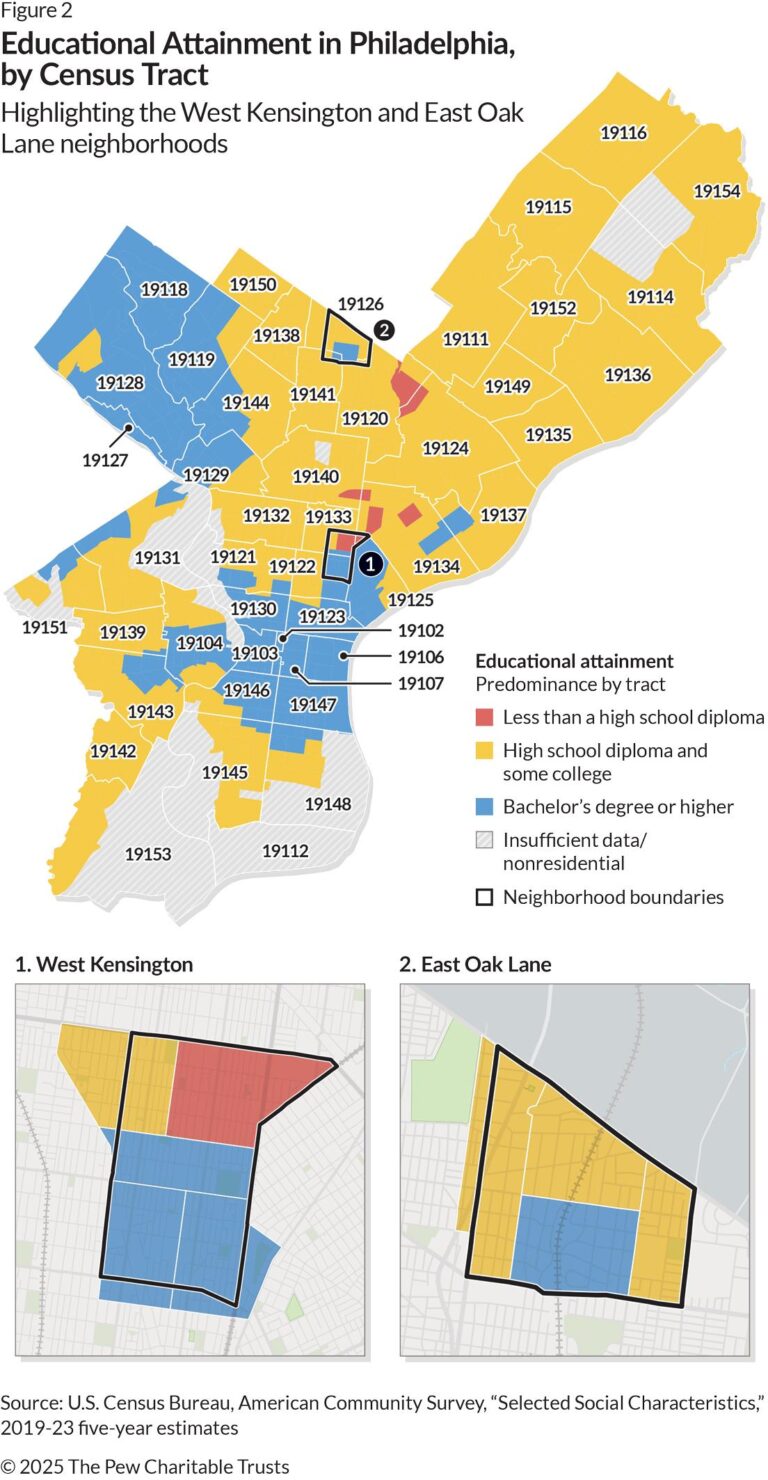Analyzing Educational Disparities in Philadelphia: A Closer Look at West Kensington and East Oak Lane
Educational achievement in Philadelphia exhibits stark contrasts between neighborhoods, mirroring broader socioeconomic inequalities. A recent analysis by The Pew Charitable Trusts offers an in-depth examination of two Philadelphia communitiesŌĆöWest Kensington and East Oak LaneŌĆöhighlighting differences in graduation rates, college attendance, and educational resource availability. This article explores these findings, comparing educational outcomes in these neighborhoods and discussing their implications for PhiladelphiaŌĆÖs pursuit of academic equity and community advancement.
How Educational Inequities Shape Neighborhood Development
The gap in educational attainment between West Kensington and East Oak Lane significantly affects the social and economic vitality of these communities. West Kensington, where fewer adults possess associate degrees or higher qualifications, experiences challenges such as limited access to lucrative employment and a heavier dependence on public assistance programs. In contrast, East Oak LaneŌĆÖs elevated educational levels are linked to enhanced economic opportunities and more robust community services. These disparities not only underscore unequal access to education but also contribute to a cycle where underfunded neighborhoods struggle to attract investment and quality educational initiatives.
- West Kensington: Characterized by lower high school graduation rates, scarce vocational training, and fewer college graduates.
- East Oak Lane: Noted for higher rates of college enrollment, community-led educational programs, and stronger local job markets.
| Metric | West Kensington | East Oak Lane |
|---|---|---|
| High School Graduation Rate | 62% | 84% |
| Adults with BachelorŌĆÖs Degree or Higher | 18% | 42% |
| Unemployment Rate | 12% | 6% |
Addressing these educational disparities is vital for the comprehensive growth of both neighborhoods. Initiatives that improve access to quality education, establish mentorship opportunities, and foster partnerships among schools, nonprofits, and businesses can drive meaningful progress. By confronting these challenges directly, Philadelphia can empower communities like West Kensington to flourish alongside more advantaged areas such as East Oak Lane.
Obstacles Hindering Higher Education Access in West Kensington and East Oak Lane
Students and families in West Kensington and East Oak Lane encounter multiple barriers that impede their pursuit of higher education. Financial hardship remains a predominant issue, with many households unable to cover tuition fees and associated costs. Furthermore, insufficient access to college preparatory resources and academic advising leaves many young people ill-prepared for the complexities of college admissions. Language differences and limited parental experience with higher education systems further complicate the journey, particularly in neighborhoods with substantial immigrant populations.
Additional social challenges include under-resourced schools that often lack rigorous curricula required for college readiness. Many students juggle part-time jobs or caregiving duties, which reduce their study time. Transportation difficulties and safety concerns also limit access to campuses and preparatory programs. The table below summarizes the most frequently reported barriers in these communities:
| Barrier | West Kensington | East Oak Lane |
|---|---|---|
| Financial Challenges | 72% | 65% |
| Limited Academic Support | 58% | 54% |
| Family and Social Responsibilities | 49% | 47% |
| Transportation Barriers | 43% | 39% |
| Language and Cultural Obstacles | 36% | 41% |
Community-Led Programs Advancing Educational Equity
Local organizations in West Kensington and East Oak Lane have launched impactful initiatives tailored to their neighborhoodsŌĆÖ specific needs. Programs such as community tutoring centers and after-school STEM clubs have effectively tackled educational gaps by offering accessible, culturally relevant support. These efforts have not only boosted academic achievement but also increased parental involvement and community participation, fostering a comprehensive approach to student development.
Key factors contributing to these successes include:
- Partnerships among schools, nonprofits, and local enterprises to secure funding and resources
- Mentorship programs connecting students with role models who share similar backgrounds
- Integration of arts and technology curricula to stimulate creativity and critical thinking
| Program | Focus | Outcomes |
|---|---|---|
| Kensington Learning Hub | After-school academic support | Reading proficiency increased by 15% |
| East Oak Lane Tech Initiative | STEM education enhancement | STEM course enrollment rose by 20% |
| Neighborhood Mentorship Alliance | Student mentorship | Graduation rates improved by 12% |
Recommendations for Strengthening Educational Outcomes
To elevate academic success in West Kensington and East Oak Lane, targeted interventions focusing on literacy and numeracy are essential. Collaboration between educational institutions and community groups should prioritize after-school tutoring, mentorship programs, and parent engagement workshops to cultivate supportive learning environments beyond traditional classrooms. Incorporating culturally responsive pedagogy and local history into teaching can also enhance student interest and relevance.
Investing in educational technology infrastructure alongside continuous professional development for educators is critical to maximizing learning benefits. Recommended strategies include:
- Ensuring equitable access to digital devices and internet connectivity for all students
- Providing ongoing teacher training focused on effective technology integration
- Establishing community learning centers equipped with educational resources and reliable internet
| Strategy | Anticipated Benefit | Implementation Timeline |
|---|---|---|
| After-school tutoring programs | Boost in academic performance and engagement | 6-12 months |
| Teacher professional development | Improved instructional quality | Ongoing |
| Community learning centers | Greater educational access | 3-6 months |
Final Thoughts
The contrasting educational profiles of West Kensington and East Oak Lane underscore the complex challenges and potential within PhiladelphiaŌĆÖs neighborhoods. Data from The Pew Charitable Trusts emphasize the necessity of focused investments in education and community support to achieve equitable academic outcomes. Moving forward, policymakers and local leaders must continue to tackle the root causes of educational disparities, ensuring that every resident has the opportunity and resources to succeed. The evolving dynamics in these communities serve as a powerful reminder of the ongoing commitment required to close gaps and foster inclusive growth citywide.








